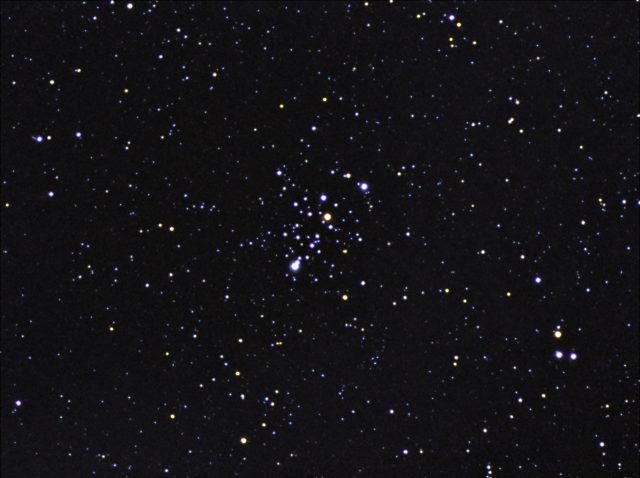


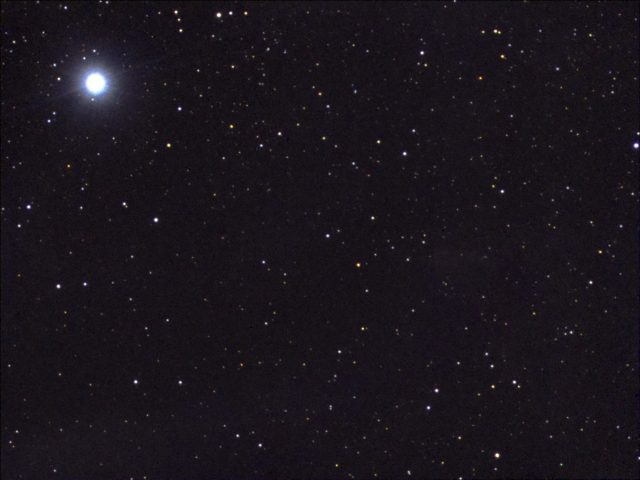
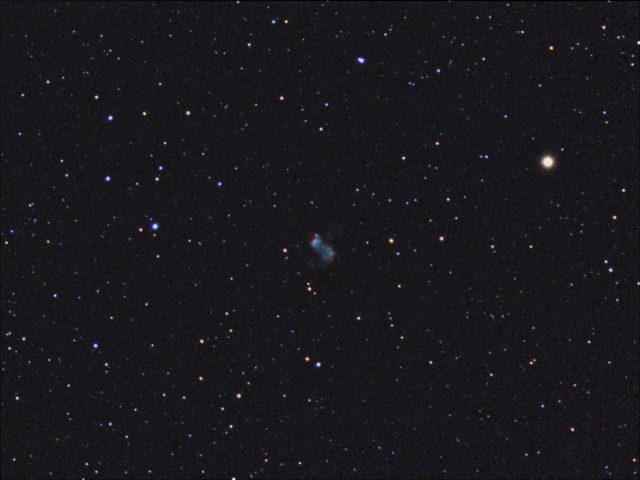
Here is a roundup of objects I was able to see during my most recent Electronically Assisted Astronomy (EAA) observing session. These were taken in a Bortle Red zone and under a nearly full moon on Dec 1, 2017.





Here is a roundup of objects I was able to see during my most recent Electronically Assisted Astronomy (EAA) observing session. These were taken in a Bortle Red zone and under a nearly full moon on Dec 1, 2017.
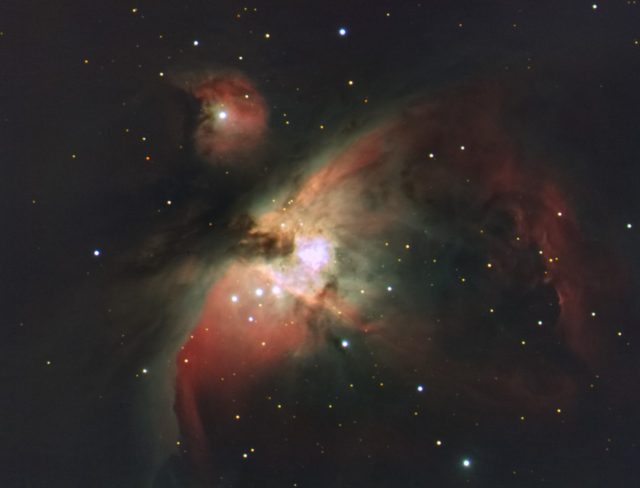
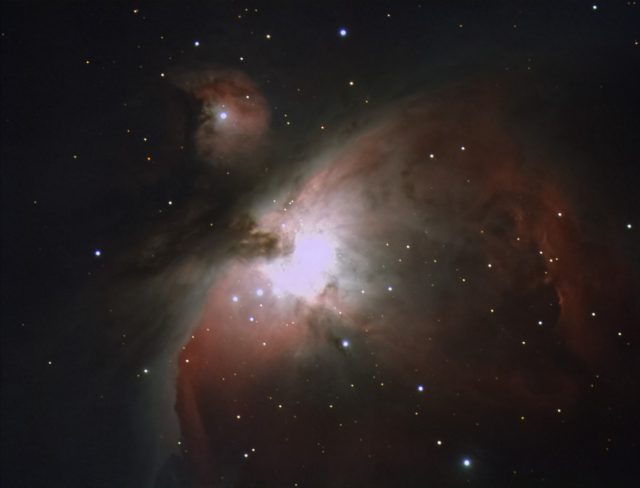
Who knew just a few years ago that I would be shooting 8 second sub-images and building up images that rival my best efforts with a DSLR camera and 180 second sub-images. Now, all I have to do is save up for one of these new breed of Sony CMOS cameras with lots more mega-pixels that can match the resolutions I get with my Canon cameras. They are not too costly anymore and the results speak for themselves.

BTW, this was shot with the bright moon nearby. I got him, too, though! 🙂
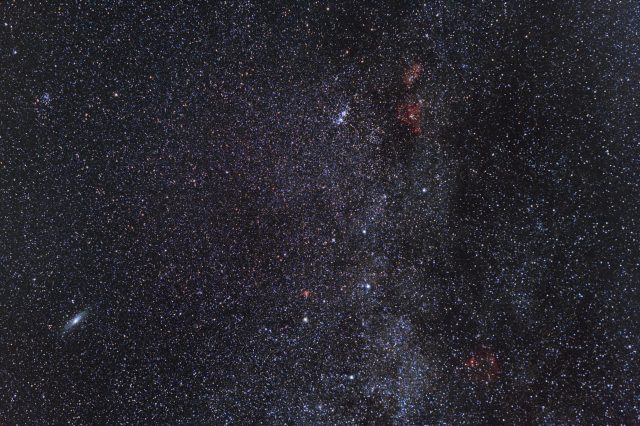
By luck I framed this one with M31 and the Cassiopeia region and got all the good nebulae that were in the area to boot. You can see the Heart and Soul Nebulae, the PacMan Nebula, emission nebula NGC 7822, and other smaller nebulae like the one near Gamma Cass. The Double Cluster is there along with lots of other open clusters.
It is not the best lens and I did do some distortion correction in PS. It was a little difficult to process since this was the first time I used the Astronomik CLS filter. Before, I had one light pollution filter and two cameras, so I finally got another one so they both have one. All I need now is a small mount for light loads like the setup I used here and I could get two cameras going at the same time. Yeah, buddy! 🙂
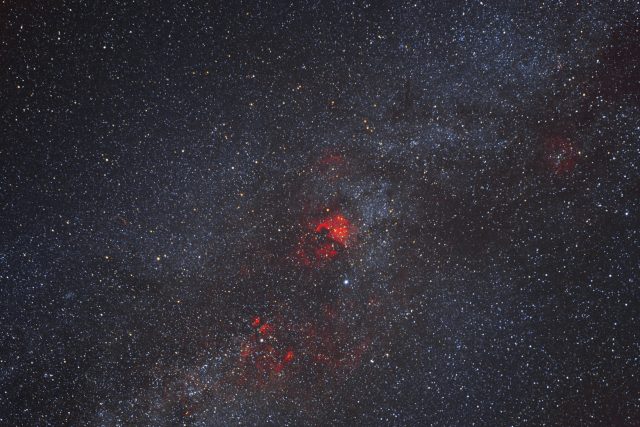
I salvaged what I could of this one. I had problems with the acquisition of the sub-images and it was mainly caused by dew. I had to wipe the lens down several times and every time I did, the focus or focal length changed. I was able to fix it by installing a dew heater strip on the lens, but that was not until the next set.
I gave up on these after an hour of fighting it. I should have installed the heater before shooting, but I was in a rush to get data and there was not any dew problems in the beginning.
But, at least I got something out of it. Anyway, here’s a portrait orientation version of the data with North at the top:
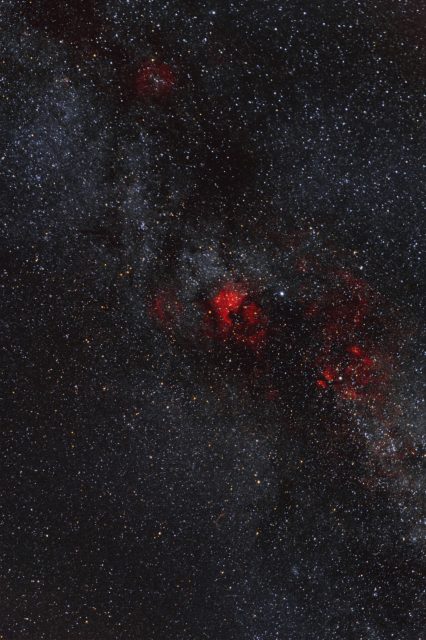
And here is a close crop of the central region:


Instead of my usual dead-end road site, I drove a few more miles west of there to a new site I’ve been wanting to try out. It is only 50 minutes total trip time and you get a borderline Bortle 3/4 site with a really dark southern and southwestern horizon.
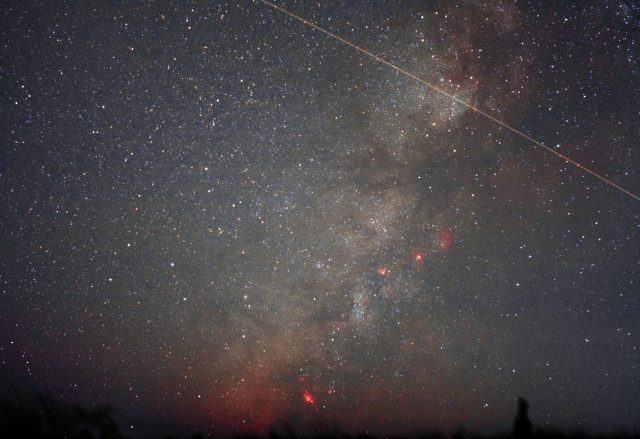
The west is pretty dark, too, but there are various small light domes from the west-northwest to the north. The northeast has a larger light dome from a metro area in that direction and the east has some smaller ones here and there. There is a line of trees from the southeast to the northeast which blocks the LP from those areas, which is good. But, it would not be the best place to shoot early morning comets, for instance, since you can’t see the eastern horizon very well because of those trees.

It is definitely dark there. Rated a 0.22 radiance level on a light pollution map. At one point, I might have glimpsed M33 naked eye, but I was not sure. If it would have been more towards the west I’m pretty sure I could have seen it. Moonrise was at midnight, so I quit early and did not get a chance to try for M33 when it was in that area of the sky. Maybe next time! 😉
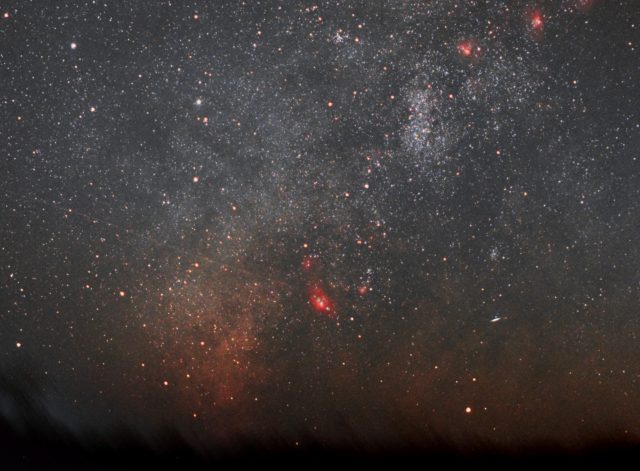
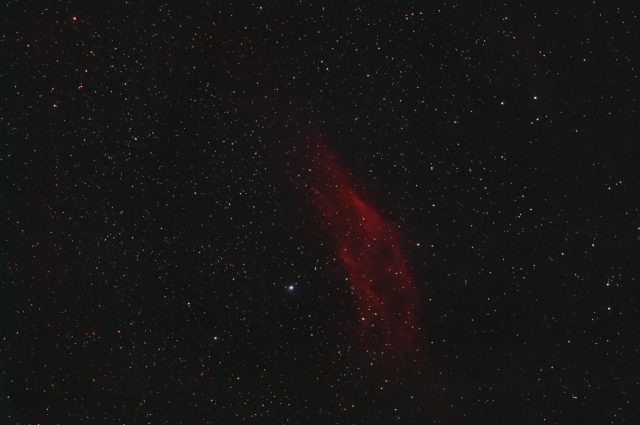
Here is a one exposure image taken in the middle of a Bortle Red Zone with 2 light pollution filters in place to help with all the LP. I managed to get quite a bit of nebulosity with 5 minute sub-images at F/2.8 and ISO 200 on my older, modified Canon XS camera.
What helped was the sky conditions, which were very transparent and clear. I am glad I did not waste one of the few great nights of the year.
The above image is just a tease, btw. I have a number of these subs just waiting to get calibrated, stacked and processed. I will probably just tack the finished product onto this thread when I am done.
Edit: Done!
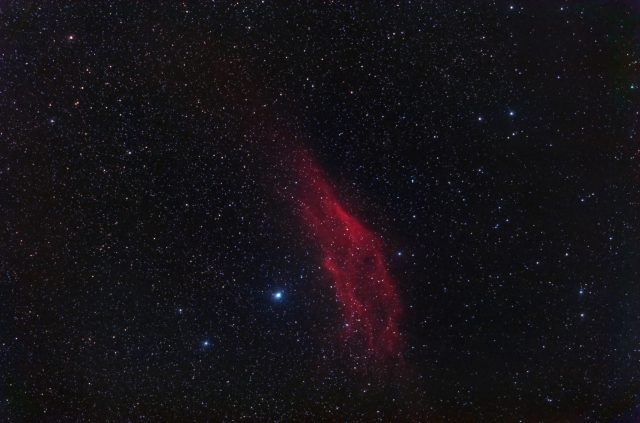
There you go. Tacked on as promised. lol I accumulated almost 2 hours worth of data and considering the location, it did not come out too bad.
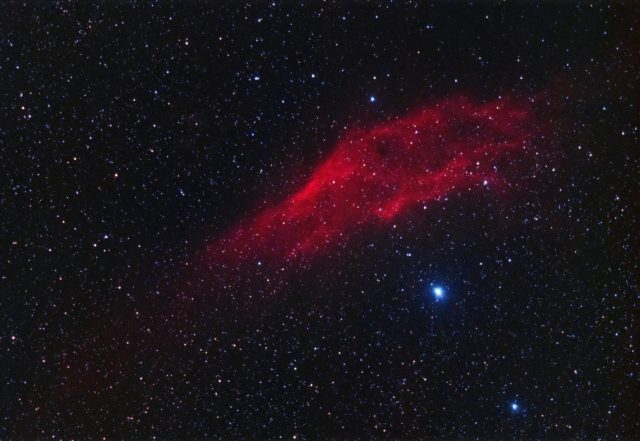
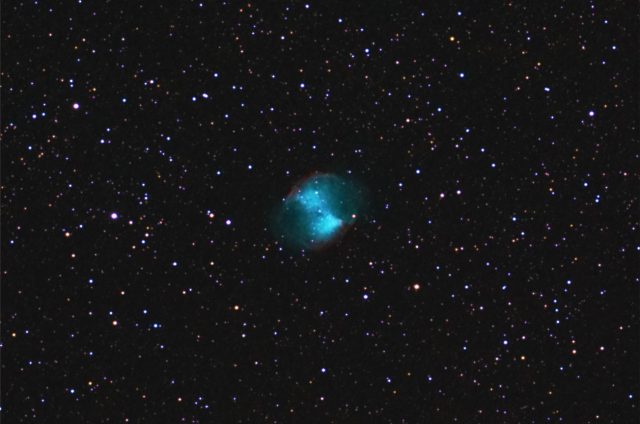
Here’s one I haven’t shot in a while. I was using it as a test to see how bad the LP would be. Not long after this was taken, Comet Lovejoy was in the same general area LP-wise, so I had a pretty good idea how much comet I might get.
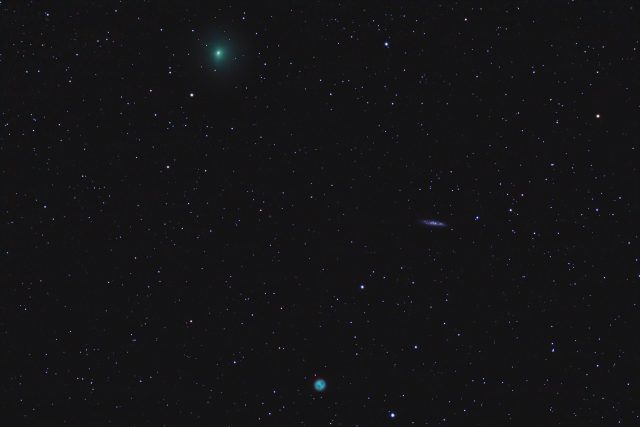
On the night following the encounter between M108, Comet 41P and the Owl Nebula, the comet was still in the field of view of my setup, so I went back for seconds. I just couldn’t pass up the opportunity to shoot a comet conjunction again!
I went with 3 minutes sub-images at ISO 200, since the 1 minute ISO 800 subs were too cooked by the LP for my taste. Unfortunately, the sky was not as transparent as the previous night and that half-stop of underexposure was needed to get around that. The trade-off was I didn’t get as much of the comet’s coma. Oh, well.
Also, at that exposure length, the comet’s pseudo-nucleus trailed a bit, since it is moving with respect to the Earth and stars and slowly picking up speed as time goes on, to boot. It was not enough to notice if I carefully over-exposed it a bit in processing to make it fatter, luckily. Check the star streaks version, which I did not overexpose, and you can see how far the comet moved in 3 minutes:
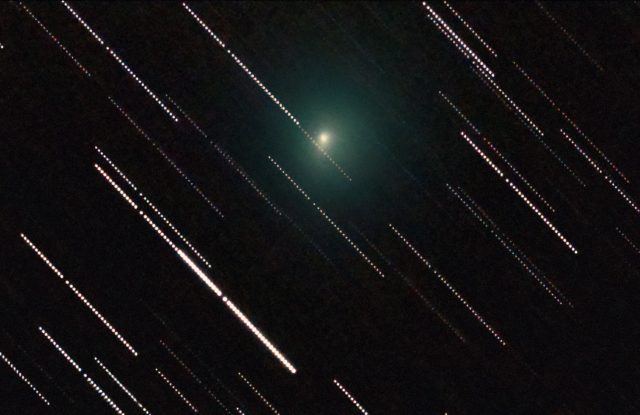
A Televue TV-85 w/0.8x focal reducer/field flattener, a Canon T3, my laptop running EQMOD, driving my Atlas EQ-G mount and PHD2 Guiding with an Orion StarShoot guider/Orion Ultra-Mini guidescope was some of the equipment used.
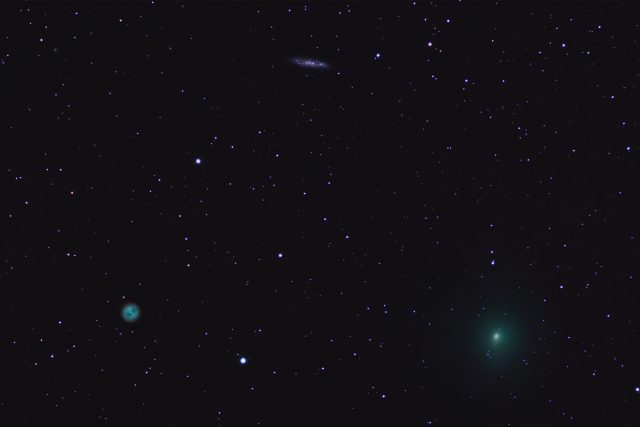
It is not uncommon for comets to pass near famous Messier objects or NGC catalog objects and put on a good show. This comet encounter is special in that there are two famous objects that the comet is having a conjunction with. One is a relatively bright galaxy called M108. The other is the Owl Nebula, one of the better planetary nebulae in the skies.
I shot this with the Canon T3 and Televue TV-85 combo. I used one minute sub-images at ISO 800 and that was about max for the skies I was under. I’m sure people with darker skies got better results. However, I think being able to pull anything out of the skies at this location is great. LP was bad and I had terrible gradients to deal with in post-processing, but I managed. 🙂
I also did a quick star-streaks version that seems to show a longer tail. Not sure, since there were some dust doughnuts left over from an apparently bad batch of flats I used and I had to clone them out. These aberrations were in the tail area, so it could be some remnant of that.
Check it out:
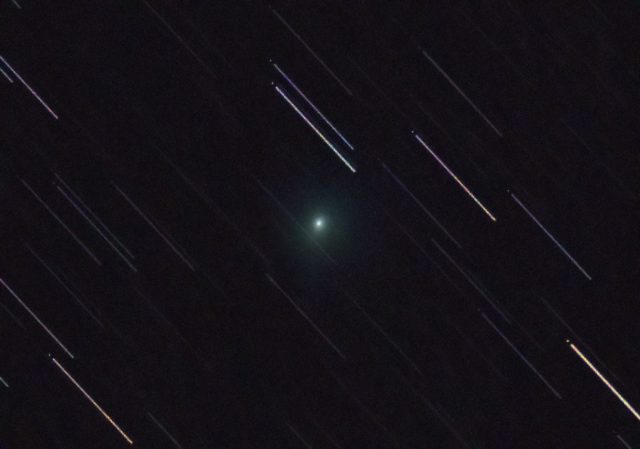
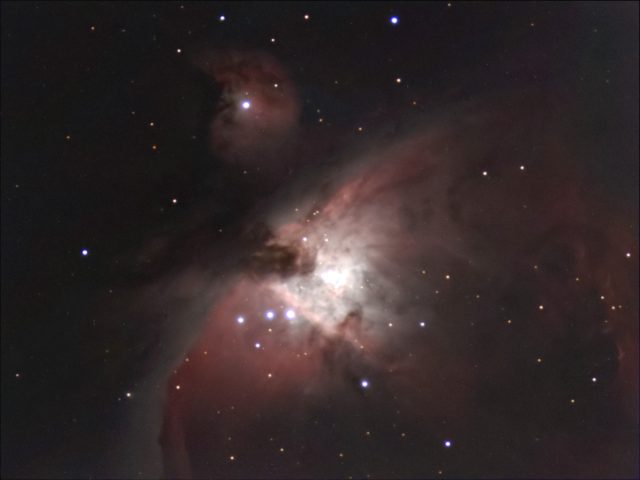
The target of choice, if it is available, is always M42 when you have some new astrophotography gear to try. I went after it as my first object of the night for this session. I missed it the previous night which was first light for the new RisingTech Sony IMX224 camera because my mount was being a pain when trying to get it aligned and pointing accurately.
This was captured in the RisingTech (RT) version of ToupSky, the software that comes with all ToupTek cameras. RT has it re-branded and calls it RisingSky. lol. I installed it, even though I already had ToupSky installed.
One thing it has that the regular download of ToupSky doesn’t have is Live Stack. It is similar to what SharpCap does and the main reason why I was using that program instead of ToupSky when I imaged with the ToupTek Aptina AR0130 camera.
It does a decent job of stacking when the stars are bright, not so decent when they are dim. About the same as SharpCap. That’s why others are using AstroToaster to live stack, since it uses DeepSkyStacker as its backend, which is more powerful than the ToupTek offering and has better calibration support.
My only gripe about RisingSky is the TIFF save and export supports only 8-bit, and I used that instead of FITS when I saved. My bad for not checking first. The post processing would have went better if I had 16-bit to start with. Live and learn, as they say.
The next night after the above image was taken, I tested the camera shooting with a 0.8X focal reducer for F/5.6. It definitely made a difference in the speed and I got more nebula with less exposure time. Plus, the field of view was wider:
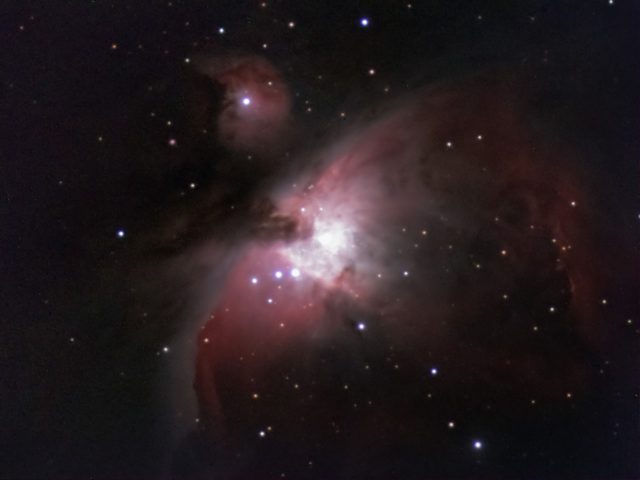
The F/5.6 setup is also better since the camera is screwed onto the focal reducer with a T to C adapter. At F/7, I had to use an 2 inch extension with a regular eyepiece holder and leave it and the camera hanging out of the focuser a ways to even reach focus. So, there is less chance of misalignment or something slipping out of place with the reducer and T to C adapter.
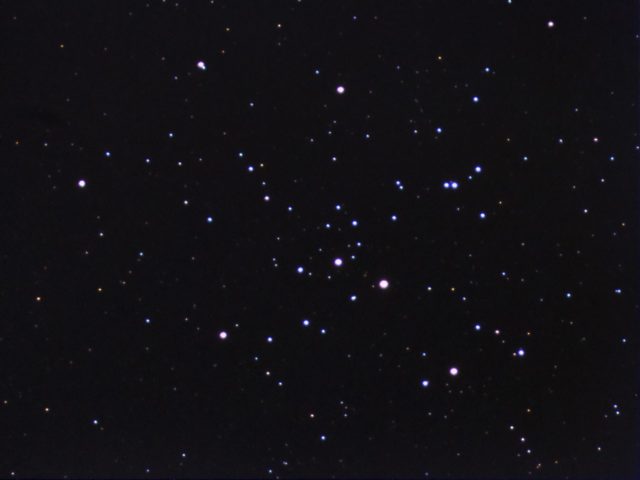
In addition to M42, I also got some time on M41, which is an open cluster in the constellation Canis Major, next door to Orion. Open clusters are too easy with this setup. I can’t wait to try it on some globular clusters!